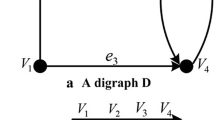Abstract
Although many ingenious mechanisms have been designed, the fundamental task of conceptualizing these devices is, to a great extent, still an art. While sophisticated computational tools for dynamic analysis of mechanisms exist, hardly any computational methods exist for generalized synthesis. To develop a computational model for synthesis, a formal foundation for mechanisms design must be laid by rationalizing the process of mechanical synthesis. Rationalization in synthesis implies that complex mechanical motions can be described in terms of primitives or building blocks. In this paper, we present a matrix methodology that forms the basis for a computable approach to design synthesis. In this methodology, the continuous design space of a mechanisms domain is discretized into functional subspaces, and each subspace is represented uniquely by a conceptual building block. The matrix scheme serves as a formal means to (a) represent and reason with the building blocks at different levels of abstraction, (b) generate alternate conceptual design configurations, and (c) facilitate rapid simulation of design concepts by connecting a series of building blocks.
Similar content being viewed by others
References
Artobolevski, I.I.,Mechanisms in Modern Engineering Design, v. 1–3, MIR Publishers, Moscow, 1986
Brown, D.C. and Chandrasekaran, B., “An Approach to Expert Systems for Mechanical Design,”Proceedings of the IEEE Trends and Applications Conference, 1983, pp. 173–180
Chase, M.A., “Using DRAM and ADAMS Programs to Simulate Machinery, Vehicles,”Agricultural Engineering, November 1978
Chironis, N.,Mechanisms, Linkages and Mechanical Controls, McGraw-Hill, 1978
Datseris, P. and Palm, W., “Principles on the Development of Mechanical Hands Which Can Manipulate Objects by Means of Active Control,” ASME Paper 84-DET-37, ASME, 1984
Datseris, P. and Lee, H.T., “Development of All Non-isomorphic Graphs for Mechanism Design with Emphasis on Robot Gripper Design,”Proceedings of the Tenth OSU Applied Mechanisms Conference, New Orleans, December 1987
Denavit, J. and Hartenberg, R.S., “A Kinematic Notation for Lower-Pair Mechanisms Based on Matrices,”Transactions of the ASME, 1955, pp. 215–221
Dixon, J.R., “Artificial Intelligence and Design: A Mechanical Engineering View,”Proceedings of the AAAI Fifth National Conference on Artificial Intelligence, v. 2, American Association of Artificial Intelligence, 1986, pp. 872–877
Erdman, A.G. and Riley, D.R., “Computer Aided Linkage Design Using LINCAGES Package,” Paper 81-DET-121, ASME, 1981
Erdman, A.G., “Forty Years of Modern Kinematics,”Proceedings of the Conference on The First Forty Years of Modern Kinematics—A Tribute to Ferdinand Freudenstein, John Wiley & Son, 1991, Ch. 3
Faltings, B., “A Theory of Qualitative Kinematics in Mechanisms,” Technical Report UIUCDCS-R-86-1274, University of Illinois at Urbana-Champaign, 1987
Forbus, K., Nielsen, P. and Faltings, B., “Qualitative Kinematics: A Framework,”Proceedings of IJCAI-87 Morgan Kaufman Publishers, Milan, 1987
Freudenstein, F. and Dobrjansky, L. “On a Theory for the Type Synthesis of Mechanisms,”Proceedings of the Eleventh International Conference of Applied Mechanics, 1964, pp. 420–428
Freudenstein, F. and Maki, E.R., “The Creation of Mechanisms According to Kinematic Structure and Function,” Research Publication GMR-3073, General Motors Research Labs., 1980
Freudenstein, F. and Maki, E.R., “Development of an optimum variable-stroke internal-combustion engine mechanism from the viewpoint of kinematic structure,”Journal of Mechanisms, Transmissions and Automation in Design v. 105, 1983, pp. 259–266
Hain, K.,Applied Kinematics, McGraw-Hill, 1961
Hoeltzel, D.A., Chieng, W.-H., and Zissimides J., “Knowledge Representation and Planning Control in an Expert System for the Creative Design of Mechanisms,”AI EDAM v. 1, n. 2, 1987, pp. 119–137
Hoeltzel, D.A. and Chieng, W.-H., “Knowledge-Based Approaches for Creative Synthesis of Mechanisms,”Computer-Aided Design v. 22, n. 1, 1990, pp. 420–428
Hubka, V. and Andreasen, M.M.,WDK 10, Proceedings of the International Conference on Engineering Design, Heurista, Copenhagen, 1983
Jones, F.D., Horton, H.L. and Newell, J.A. (eds.),Ingenious Mechanisms for Designers and Inventors New York: Industrial Press, 1986
Joskowicz, L., “Simplification and Abstraction of Kinematic Behaviors,”Proceedings of the Eleventh International Joint Conference on Artificial Intelligence, Detroit, 1989, pp. 1337–1342
Kannapan, S.M. and Marshek, K.M., “An Algebraic and Predicate Logic Approach to Representation and Reasoning in Machine Design,”Mechanisms and Machine Theory v. 25, n. 3, 1990, pp. 335–353
Kota, S., Erdman, A.G. and Riley, D.R., “Development of knowledge-base for designing linkage-type dwell mechanisms: Part 1-Theory,” ASME Transactions 86-DET-47, ASME, 1986
Kota, S., Erdman, A.G. and Riley, D.R., “Development of knowledge-base for designing linkage-type dwell mechanisms: Part 2—Application,” ASME Transactions 86-DET-48, ASME, 1986
Kota, S., Erdman, A.G., Riley, D.R., Esterline, A. and Slagle, J.R., “A Network-based Expert System for Intelligent Design of Mechanisms,”AI EDAM v. 2, n. 1, 1988, pp. 17–32
Kota, S. and Lee, C.-L., “A Functional Framework for Hydraulic Systems Design Using Abstraction/Decomposition Hierarchies,”ASME International Computers in Engineering Conference American Society of Mechanical Engineers, Boston, August 1990
Kramer, S. and Premkumar, P., “A Generalized Expert System Shell for Implementing Mechanical Design Applications: Review, Introduction and Fundamental Concepts,”Proceedings of the 1988 ASME Design Automation Conference, American Society of Mechanical Engineers, 1988
Mittal, S. and Frayman, F., “Towards a Generic Model of Configuration Tasks,”Proceedings of the Eleventh International Joint Conference on Artificial Intelligence, v. 2, Detroit, August 1989, pp. 1395–1402
Mostow, J., “Toward Better Models of the Design Process,”AI Magazine, Spring 1985, pp. 44–57
Olson, D.G., Erdman, A.G. and Riley, D.R., “A Systematic Procedure for Type Synthesis of Mechanisms with Literature Review,”Mechanisms and Machine Theory v. 20, 1985, pp. 285–295
Pahl, G. and Beitz, W.,Engineering Design The Design Council, Springer-Verlag, London, 1984
Kennedy, A.B.W., ed.,The Kinematics of Machinery Dover Publications (reprint), New York, 1854
Simon, H.A.,The Sciences of the Artificial MIT Press, Cambridge, MA, 1969
Soni, A.H., Dado, M. and Weng, Y., “An Automated Procedure for Intelligent Mechanism Selection and Dimensional Synthesis,” ASME Transactions 86-DET-14, ASME, 1986
Thompson, T.R., Riley, D.R. and Erdman, A.G., “An Expert System Approach to Type Synthesis of Mechanisms,”Proceedings of the ASME Computers in Engineering Conference American Society of Mechanical Engineers, Boston, MA, November 1985, pp. 71–76
Author information
Authors and Affiliations
Rights and permissions
About this article
Cite this article
Kota, S., Chiou, SJ. Conceptual design of mechanisms based on computational synthesis and simulation of kinematic building blocks. Research in Engineering Design 4, 75–87 (1992). https://doi.org/10.1007/BF01580146
Issue Date:
DOI: https://doi.org/10.1007/BF01580146




